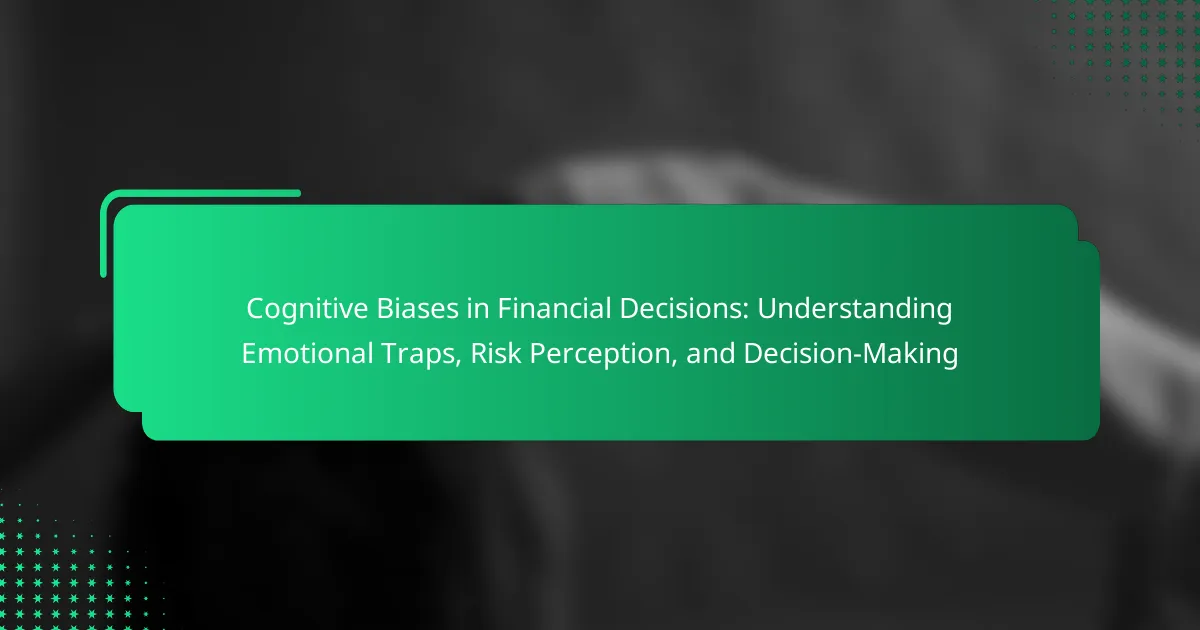Cognitive biases significantly impact financial decisions, often leading to irrational choices and emotional traps. This article explores common biases like overconfidence and loss aversion, examines their effects on risk perception, and highlights strategies for improving decision-making processes. Understanding these biases is crucial for achieving better financial outcomes and making informed investment choices.

Cognitive Biases in Financial Decisions: What are They?
Cognitive biases in financial decisions are mental shortcuts that lead to irrational choices. These biases affect risk perception, emotional responses, and overall decision-making processes. Common biases include overconfidence, loss aversion, and anchoring. These can distort an investor’s judgment, often resulting in suboptimal financial outcomes. Understanding these biases is essential for making informed financial decisions.
How do Cognitive Biases Influence Our Financial Choices?
Cognitive biases significantly impact financial choices by distorting perception and decision-making. Emotional traps, such as loss aversion and overconfidence, lead to irrational behaviors that can undermine financial stability. For instance, loss aversion causes individuals to fear losses more than they value gains, often resulting in overly conservative investment strategies. Additionally, biases like anchoring can skew risk perception, where initial information unduly influences subsequent decisions. Understanding these biases enables individuals to make more informed financial choices, enhancing overall financial well-being.
What Emotional Traps are Common in Financial Decision-Making?
Common emotional traps in financial decision-making include overconfidence, loss aversion, and anchoring bias. Overconfidence leads individuals to underestimate risks, often resulting in poor investment choices. Loss aversion causes a stronger reaction to losses than to gains, which can hinder rational decision-making. Anchoring bias occurs when people rely too heavily on initial information, impacting their evaluations of future financial opportunities. Recognizing these biases can improve financial outcomes.
What is Loss Aversion and How Does it Impact Decisions?
Loss aversion is a cognitive bias where individuals prefer to avoid losses rather than acquiring equivalent gains. This bias significantly impacts financial decisions by skewing risk perception and leading to overly conservative choices. Research shows that losses are psychologically about twice as powerful as gains, causing people to hold onto losing investments longer than they should. As a result, loss aversion can hinder optimal decision-making and lead to missed opportunities for profit.
How Does Overconfidence Affect Financial Outcomes?
Overconfidence can lead to poor financial outcomes by distorting risk perception and decision-making. Individuals often overestimate their knowledge and abilities, resulting in excessive risk-taking. This bias can cause investors to ignore market signals and make unwise investments. Studies show that overconfident investors tend to trade more frequently, which typically reduces their returns. As a result, they may experience greater financial losses than those who maintain a realistic view of their capabilities.
How Does Risk Perception Shape Financial Behaviour?
Risk perception significantly influences financial behavior by shaping decision-making processes. Individuals often fall prey to cognitive biases, which can skew their understanding of risk. For instance, overconfidence may lead investors to underestimate potential losses, while loss aversion can result in irrational avoidance of risk. Emotional traps, such as fear and greed, further complicate financial choices, making it essential for individuals to recognize these biases. Understanding how risk perception interacts with emotions can empower better financial decisions and promote healthier financial behaviors.
What Role Does Anchoring Play in Financial Judgments?
Anchoring significantly influences financial judgments by establishing reference points that affect decision-making. Individuals often rely on initial information, or anchors, which can lead to biased evaluations of investments and risks. For instance, a high initial price can skew perceptions of value, resulting in overestimating worth. This cognitive bias can distort risk assessment and lead to suboptimal financial choices. Understanding anchoring helps in recognizing emotional traps in financial decisions, allowing for more rational evaluations.
How Does Availability Heuristic Influence Investment Choices?
The availability heuristic significantly influences investment choices by causing individuals to rely on immediate examples that come to mind. This cognitive bias can lead to skewed perceptions of risk and opportunity. For instance, investors may overestimate the likelihood of recent market events affecting their decisions. As a result, they might chase trends or avoid certain investments based on emotional responses rather than objective analysis. Understanding this bias helps investors make more informed and rational decisions.

What are the Universal Attributes of Cognitive Biases?
Cognitive biases universally affect decision-making by distorting perception and judgment. Key attributes include emotional influence, risk assessment errors, and heuristic shortcuts. These biases lead to systematic deviations from rationality, impacting financial choices and overall decision quality. Understanding these attributes helps mitigate their effects in financial contexts.
How Do Cognitive Biases Affect Different Demographics?
Cognitive biases significantly influence financial decisions across different demographics. Factors such as age, education, and cultural background shape how individuals perceive risks and make choices.
Older adults often exhibit loss aversion, prioritizing the avoidance of losses over potential gains. In contrast, younger individuals may show more optimism bias, underestimating risks associated with investments.
Education level also plays a role; those with higher financial literacy tend to recognize and mitigate cognitive biases, leading to more rational decision-making. Cultural differences can further impact how biases manifest, as some cultures may emphasize collective decision-making over individual risk-taking.
Understanding these demographic variations is crucial for tailoring financial advice and interventions, ensuring they resonate with specific audience needs.
What Are Common Patterns in Financial Mistakes?
Cognitive biases often lead to common financial mistakes. These include overconfidence, loss aversion, and anchoring, which distort risk perception and decision-making. Overconfidence can cause investors to underestimate risks, while loss aversion may lead to holding onto losing investments. Anchoring occurs when individuals rely too heavily on initial information, skewing their financial judgments. Recognizing these patterns can significantly improve financial decision-making.

What Unique Attributes Distinguish Cognitive Biases in Financial Decisions?
Cognitive biases in financial decisions are distinguished by unique attributes such as overconfidence, loss aversion, and anchoring. Overconfidence leads investors to overestimate their knowledge and predictive abilities, often resulting in poor investment choices. Loss aversion causes individuals to prefer avoiding losses over acquiring equivalent gains, significantly impacting risk perception. Anchoring affects decision-making by relying too heavily on initial information, which can skew financial judgments. These unique attributes create emotional traps that can hinder rational financial decision-making.
How Do Cultural Factors Influence Cognitive Biases?
Cultural factors significantly influence cognitive biases in financial decisions by shaping emotional responses and risk perceptions. For instance, collectivist cultures may prioritize group consensus, affecting individual decision-making. Cultural norms also dictate attitudes towards uncertainty and risk, leading to distinct emotional traps. Understanding these influences is crucial for better decision-making strategies.
What Unique Biases are Found in Investment Strategies?
Cognitive biases uniquely influence investment strategies by distorting risk perception and decision-making. Common biases include overconfidence, loss aversion, and anchoring. These biases can lead to emotional traps, resulting in poor investment choices. For example, overconfidence may cause investors to underestimate risks, while loss aversion can result in holding losing investments too long. Understanding these biases is crucial for improving financial decision-making and achieving better investment outcomes.

What are the Rare Attributes of Cognitive Biases?
Cognitive biases have unique attributes that significantly influence financial decisions. Rare attributes include the tendency for overconfidence, which leads to underestimating risks, and the framing effect, where decisions change based on how information is presented. These biases can distort risk perception and create emotional traps, ultimately affecting decision-making outcomes. Understanding these rare attributes can enhance awareness and improve financial choices.
How Do Extreme Financial Situations Expose Rare Biases?
Extreme financial situations reveal rare cognitive biases that distort decision-making. Stress and uncertainty amplify emotional traps, leading to overreactions or avoidance. For example, loss aversion may cause individuals to hold onto failing investments. These biases, often subconscious, can significantly impact financial outcomes. Understanding these influences is crucial for improving decision-making in high-stakes scenarios.
What Are the Consequences of Ignoring Rare Cognitive Biases?
Ignoring rare cognitive biases can lead to significant financial mistakes. These biases skew risk perception, resulting in poor decision-making. For instance, overconfidence bias may cause investors to underestimate risks, leading to substantial losses. Additionally, neglecting these biases can hinder effective emotional regulation, exacerbating stress and impulsive choices. Long-term consequences include diminished financial stability and missed opportunities for growth. Addressing these biases is crucial for sound financial decisions.

How Can Understanding Cognitive Biases Improve Financial Decision-Making?
Understanding cognitive biases can significantly enhance financial decision-making by minimizing emotional traps and improving risk assessment. Cognitive biases, such as overconfidence and loss aversion, often distort perceptions of risk and reward. Recognizing these biases allows individuals to make more rational choices, leading to better investment strategies and financial outcomes.
For example, awareness of the anchoring bias helps investors avoid being overly influenced by initial information. This understanding can lead to more informed evaluations of assets and market conditions. Additionally, acknowledging confirmation bias encourages individuals to seek diverse viewpoints, reducing the likelihood of poor financial decisions based on flawed reasoning.
In summary, understanding cognitive biases fosters a more objective approach to financial decision-making, promoting healthier financial behaviors and improved long-term results.
What Best Practices Can Help Mitigate Cognitive Biases?
To mitigate cognitive biases in financial decisions, implement structured decision-making processes. Utilize techniques such as pre-commitment strategies, which help clarify goals and prevent impulsive choices. Encourage diverse perspectives during discussions to counteract groupthink and enhance risk perception. Regularly review past decisions to identify biases and improve future judgment.
What Common Mistakes Should Be Avoided in Financial Decisions?
Avoiding common mistakes in financial decisions involves recognizing cognitive biases. Emotional traps, such as overconfidence and loss aversion, distort risk perception and lead to poor choices. Decision-making can be improved by seeking diverse perspectives and relying on data rather than emotions. Regularly reflecting on past decisions helps identify and mitigate these biases.
How Can One Develop a More Rational Financial Mindset?
To develop a more rational financial mindset, one must recognize and mitigate cognitive biases. Cognitive biases, such as loss aversion and overconfidence, significantly influence emotional traps and risk perception in financial decisions. Acknowledging these biases allows for more objective decision-making and improved financial outcomes.
Understanding the impact of emotions on financial choices is crucial. For example, fear of losing money can lead to overly conservative investments, while excessive optimism may result in risky ventures. By analyzing past decisions and their outcomes, individuals can identify patterns influenced by cognitive biases.
Implementing strategies to counteract these biases can enhance financial rationality. Techniques such as setting clear financial goals, conducting thorough research, and seeking external opinions can provide a balanced perspective. Regular reflection on decision-making processes fosters a more analytical approach to finances.
Ultimately, developing a rational financial mindset involves continuous learning and self-awareness. By actively addressing cognitive biases, individuals can make informed financial choices that align with their long-term objectives.


